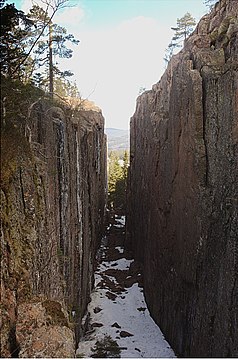Skuleskogen National Park
| Skuleskogen National Park | ||
|---|---|---|
|
|
||
| Location: | Västernorrland County , Sweden | |
| Next city: | Örnsköldsvik | |
| Surface: | 23.6 km² | |
| Founding: | 1984 | |
| The Slåttdalsskrevan gorge | ||
The Skuleskogen National Park, established in 1984 with a total area of 2360 hectares, is located in a mountainous, very varied coastal region on the Baltic Sea south of Örnsköldsvik . The region called Höga Kusten (The High Coast) is located where the inland ice was thickest in the last Ice Age, and thus the land was pushed furthest down. After the glaciers melted, the land rose and this beautiful landscape developed.
geography
Striking, rocky hilltops, pine forests, deep valleys shaped by inland ice and calm mountain lakes characterize the park. Most of the rock bedrock in the park consists of Rapakiwig granite . In addition, there are moors and scree slopes in the area of the former sea level, which is here at over 285 meters above sea level due to the postglacial land elevation . The biggest attraction in the park is the Slåtterdalskrevan , a 200 m long gorge with 40 m high vertical walls , presumably a result of the faster weathering of a diabase dike .
There are 30 km of marked hiking trails (including the Höga kustenleden long-distance hiking trail , which leads through the area) with free, freely accessible overnight and rest huts as well as an information center ( Naturum ) on Europastraße 4 . The approach is from the south via Docksta or from the north via Näske .
Flora and fauna
The animals in the park include moose , deer , lynx , bears , foxes, badgers and some rare species of birds. The forest consists mostly of spruce in the valleys and (crippled) pine forest on the scree slopes. The occurrence of the long-beard lichen (Usnea longissima) is remarkable, a slowly growing species of lichen that has become rare and which is completely dependent on the community with the spruce. The forest in the valleys was almost completely cut down at the end of the 19th century, but it was able to recover very quickly and has now grown like a jungle in some places after about 130 years.
Another special feature of the national park is its border location for the distribution of southern and northern species. So here z. B. Linden , maple and hazel reach their northern limit of distribution, while typical fell plants such as alpine milk lettuce , common alpine lattice and alpine light carnation reach their southern limit of distribution.
Web links
- Skuleskogen, Västernorrlands Lan
- Skuleskogen National Park - Visitor Guide
- Swedish homepage of the National Park Information Center





